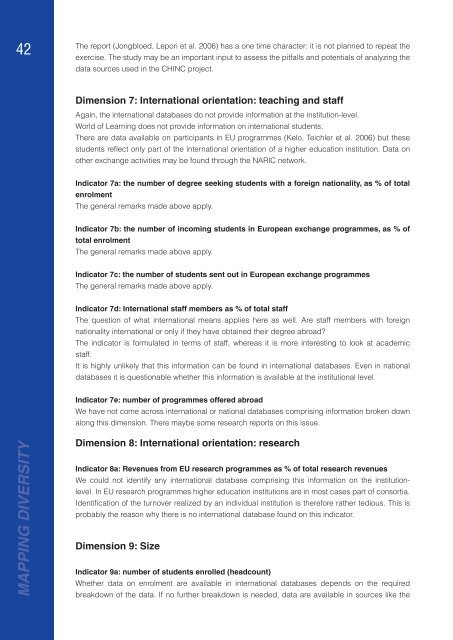Mapping Diversity: Developing a European Classification of ... - U-Map
Mapping Diversity: Developing a European Classification of ... - U-Map
Mapping Diversity: Developing a European Classification of ... - U-Map
Create successful ePaper yourself
Turn your PDF publications into a flip-book with our unique Google optimized e-Paper software.
The report (Jongbloed, Lepori et al. 2006) has a one time character: it is not planned to repeat the<br />
42<br />
exercise. The study may be an important input to assess the pitfalls and potentials <strong>of</strong> analyzing the<br />
data sources used in the CHINC project.<br />
Dimension 7: International orientation: teaching and staff<br />
Again, the international databases do not provide information at the institution-level.<br />
World <strong>of</strong> Learning does not provide information on international students.<br />
There are data available on participants in EU programmes (Kelo, Teichler et al. 2006) but these<br />
students refl ect only part <strong>of</strong> the international orientation <strong>of</strong> a higher education institution. Data on<br />
other exchange activities may be found through the NARIC network.<br />
Indicator 7a: the number <strong>of</strong> degree seeking students with a foreign nationality, as % <strong>of</strong> total<br />
enrolment<br />
The general remarks made above apply.<br />
Indicator 7b: the number <strong>of</strong> incoming students in <strong>European</strong> exchange programmes, as % <strong>of</strong><br />
total enrolment<br />
The general remarks made above apply.<br />
Indicator 7c: the number <strong>of</strong> students sent out in <strong>European</strong> exchange programmes<br />
The general remarks made above apply.<br />
Indicator 7d: International staff members as % <strong>of</strong> total staff<br />
The question <strong>of</strong> what international means applies here as well. Are staff members with foreign<br />
nationality international or only if they have obtained their degree abroad?<br />
The indicator is formulated in terms <strong>of</strong> staff, whereas it is more interesting to look at academic<br />
staff.<br />
It is highly unlikely that this information can be found in international databases. Even in national<br />
databases it is questionable whether this information is available at the institutional level.<br />
Indicator 7e: number <strong>of</strong> programmes <strong>of</strong>fered abroad<br />
We have not come across international or national databases comprising information broken down<br />
along this dimension. There maybe some research reports on this issue.<br />
MAPPING DIVERSITY<br />
Dimension 8: International orientation: research<br />
Indicator 8a: Revenues from EU research programmes as % <strong>of</strong> total research revenues<br />
We could not identify any international database comprising this information on the institutionlevel.<br />
In EU research programmes higher education institutions are in most cases part <strong>of</strong> consortia.<br />
Identifi cation <strong>of</strong> the turnover realized by an individual institution is therefore rather tedious. This is<br />
probably the reason why there is no international database found on this indicator.<br />
Dimension 9: Size<br />
Indicator 9a: number <strong>of</strong> students enrolled (headcount)<br />
Whether data on enrolment are available in international databases depends on the required<br />
breakdown <strong>of</strong> the data. If no further breakdown is needed, data are available in sources like the

















